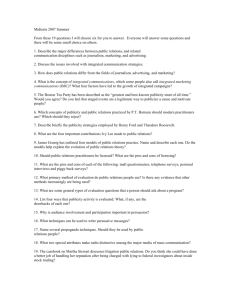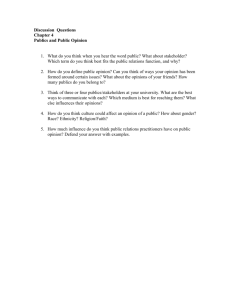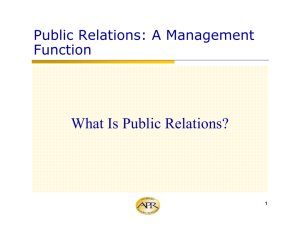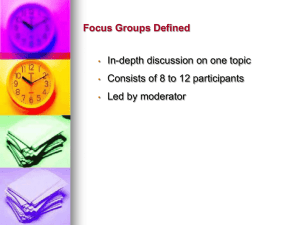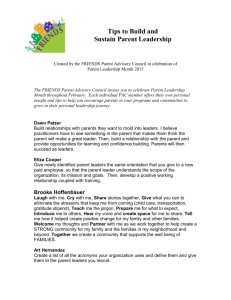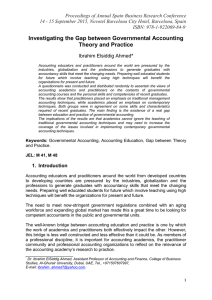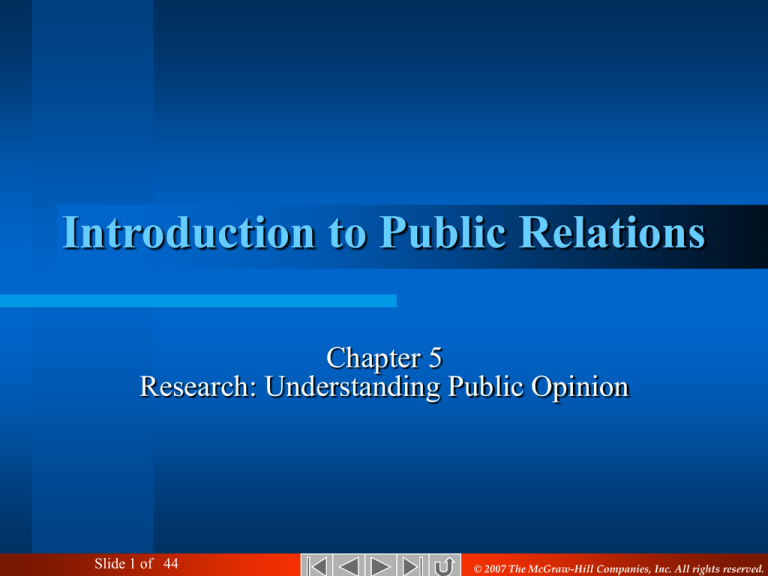
Introduction to Public Relations
Chapter 5
Research: Understanding Public Opinion
Slide 1 of 44
© 2007 The McGraw-Hill Companies, Inc. All rights reserved.
Introduction to Public Relations
Public Relations Research
WHY RESEARCH?
“The most compelling reason for using research is to make sure
that your program is the best it can be -- that what you are doing
is as ‘right on’ as it can be.”
Blair C. Jackson
SVP, Rogers & Cowan, Inc.
Slide 2 of 44
Introduction to Public Relations
Public Relations Research
WHY RESEARCH IS NECESSARY
•
•
•
•
Achieve greater credibility with facts and figures
Better define and reach target audiences
Formulate correct strategy
Test messages with target audiences
(continued on next slide)
Slide 3 of 44
Introduction to Public Relations
Public Relations Research
WHY RESEARCH IS NECESSARY
•
•
•
•
•
•
Help “isolated” senior management keep in touch
Prevent crises (“smoldering fires”)
Monitor competition and industry trends
Influence public opinion
Generate publicity
Measure success
Slide 4 of 44
Introduction to Public Relations
Public Relations Research
Are you ready for research?
Public relations is increasingly scientific and data driven
•
•
•
•
•
Statistics and probability
Research methodology
Constructing and administering surveys
Conducting focus groups
Working with charts and graphs
Slide 5 of 44
Introduction to Public Relations
Public Relations Research
The Four-Step Process Is The Foundation
For The Practice Of Public Relations
Research
Planning
Evaluation
Action
Slide 6 of 44
Introduction to Public Relations
Public Relations Research
The Role of Research
Research enables practitioners to:
•
Identify and define publics involved in specific
problems.
•
Pretest messages and media to ensure that programs
will produce the best possible results.
•
•
Evaluate the results of programs and campaigns.
Design and execute follow-up activities.
Slide 7 of 44
Introduction to Public Relations
Public Relations Research
Tips for Researching Your Publics
•
•
•
•
•
•
Avoid the general public
Define broad categories
Narrow to definable
components
Set priorities
Identify gatekeepers
Examine Overlap
Let’s consider an example…
Slide 8 of 44
Introduction to Public Relations
Public Relations Research
Questions to Begin Research
•
•
•
What preliminary research is
needed?
What informal research will
help?
Which formal research
techniques do you need?
•
•
•
Survey
Content analysis
Experimental
Zooming in on Preliminary research…
Slide 9 of 44
Introduction to Public Relations
Public Relations Research
Preliminary Research
We often begin by doing secondary research such as:
• Internet
• Databases
• Libraries
• Electronic Publications
• Government Documents and Web sites
• Professional Organizations
Slide 10 of 44
Introduction to Public Relations
Public Relations Research
The Internet and World Wide Web
Provide Access To …
•
•
•
•
•
Search engines
Online publishers
Governmental agency databases
Professional and business web sites
Corporate web sites
Slide 11 of 44
Introduction to Public Relations
Public Relations Research
Governmental Agencies
•
Information compiled by governmental agencies at
all levels is accessible via the Internet. Included are
databases from…
•
U.S. Census Bureau
•
Department of Labor (Bureau of Labor Statistics)
•
U.S. Securities and Exchange Commission (SEC)
Slide 12 of 44
Introduction to Public Relations
Public Relations Research
Professional And Business Organizations
Many organizations maintain Web sites that
may contain …
•
•
•
Survey data dealing with their industries and/or
members.
Archives of their news releases, annual reports, fact
sheets, white papers and other documents.
Links to other sites or files containing information of
value to practitioners.
Now let’s look at content analysis …
Slide 13 of 44
Introduction to Public Relations
Public Relations Research
Preliminary Research Techniques
•
•
•
•
•
Analyzing news clippings (“clips”)
Interviewing key contacts or centers of influence
Organizing committees or study panels
Practicing ‘casual monitoring’ through phone calls, e-mail,
letters, observation
Using focus groups
Slide 14 of 44
Introduction to Public Relations
Public Relations Research
Using Focus Groups
•
•
•
Understand group
dynamics and how to
solicit participation
Interview using openended questions to prompt
interaction and gain
insights
Videotape so that
researchers can examine
nonverbal as well as verbal
expressions
Slide 15 of 44
Introduction to Public Relations
Public Relations Research
Casual Monitoring
Public relations practitioners often monitor information
that routinely comes to their attention, including:
•
•
•
Print and electronic news reports, monitored for
quantity and quality of coverage.
Incoming mail, telephone calls, sales reports and other
documents.
Content of business and industry publications, trade
association reports, and the like.
What other information sources
might you monitor?
Slide 16 of 44
Introduction to Public Relations
Public Relations Research
Most Used Research Techniques
Informal research techniques are most often used by
practitioners. The six listed most often in one study:
•
•
•
•
•
•
Literature searches and electronic retrieval
Publicity tracking
Telephone/mail surveys with simple cross-tabs
Focus groups
Communication audits
Secondary analysis studies
Slide 17 of 44
Introduction to Public Relations
Public Relations Research
Formal Research Techniques
•
•
Survey Research--this is the
formal tool used 90% of the
time in public relations.
Content Analysis--statistical
Formal research may be conducted at…
Slide 18 of 44
Introduction to Public Relations
Public Relations Research
Content Analysis
Content analysis is a process through which
information can be converted into quantitative data.
The process applies equally to:
•
•
•
Printed materials of all kinds
Transcripts of broadcast information
Transcripts of focus group interviews
How does it work?
Slide 19 of 44
Introduction to Public Relations
Public Relations Research
Experimental Research
Experimental research encompasses…
•
•
Laboratory experiments conducted in controlled
environments to minimize external factors
Field experiments, in which control is sacrificed to
observe reactions to real environments.
Slide 20 of 44
Introduction to Public Relations
Public Relations Research
Survey Research
•
•
•
•
Survey research in public relations examines the
attitudes and opinions of audience members.
Surveys may be administered by mail, e-mail, phone or
in person.
Random sampling necessary to produce accurate
results.
Surveys often have marketing, publicity value
Slide 21 of 44
Introduction to Public Relations
Public Relations Research
Tools used in PR research
Slide 22 of 44
Introduction to Public Relations
Slide 23 of 44
Public Relations Research
Introduction to Public Relations
Slide 24 of 44
Public Relations Research
Introduction to Public Relations
Public Relations Research
More Research Terms
Click on the picture to hear some more research terms and explanations.
Slide 25 of 44

